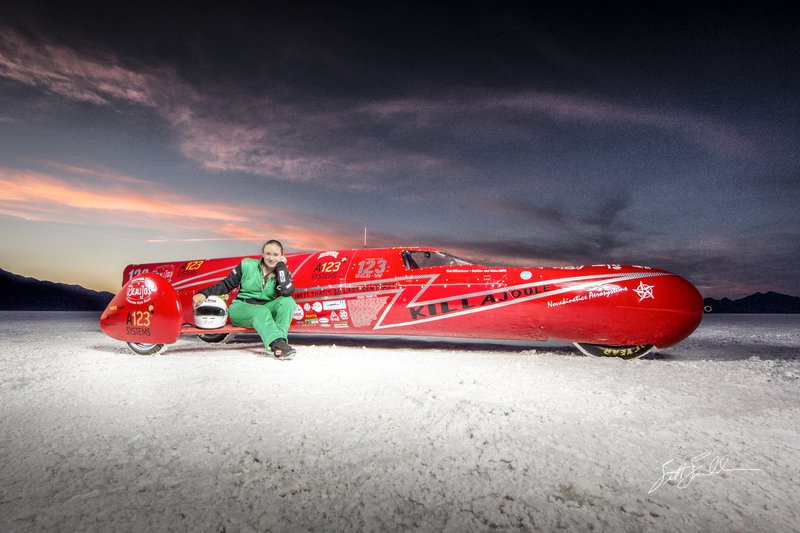11 Jun 2019
Auckland-based mechanical engineering lecturer Eva Hakansson became the world’s fastest female motorcycle rider at 434 kph. She builds her electric streamliner motorcycles from scratch and spends most of her spare time on race-related activities.
How did you get into racing?
It’s a “genetic disease” – my father was a champion Swedish motorcycle rider/builder in the 1960s.
How did your upbringing contribute to your achievements?
Everyone in my family is an engineer. My mother jokingly claims the “statute of limitations” has expired on her mechanical engineering degree. She has taken up 3D printing in her retirement, so that might still be considered engineering.
What’s your biggest project right now?
We’re building a new, much more powerful, electric motorcycle, the Green Envy, that will have over 1000 HP. The goal is the overall motorcycle land speed record, currently at 605 kph. It will be crowd funded and I am hoping to start a movement to kick the butt of internal combustion, which has held the speed record for more than 100 years.
Are there any parallels between engineering and racing?
Land speed racing, and building the vehicle, is primarily engineering – design, analysis, materials science, project management.

Eva Hakansson, Lecturer in Mechanical Engineering, the University of Auckland Photo: Scott Sneddon/DIY Photography
How do those closest to you support your passion?
My husband, Bill Dubé, is my racing “addiction enabler”. We encourage each other. He, and his electric drag bike, the KillaCycle are a fixture in electric vehicle (EV) racing. We met when I requested permission to publish a photo of the KillaCycle in a small book I published on EVs.
What’s your ultimate goal with racing?
To be the fastest. Also, to demonstrate the capabilities and desirability of EVs and encourage STEM education in children, particularly girls.
What’s the most innovative technology you’ve used when building a bike?
I use surprisingly conventional technology, just cleverly packaged! The heart of the vehicle is the battery pack. The most innovative thing is probably my own effort to “re-invent the wheel”. The Green Envy is being built for 650+ kph, and there are no suitable tyres for that kind of speed and size of vehicle. I’ve been working on an idea for a non-pneumatic wheel with rubber grip for a few years, and ran these new wheels – dubbed KiWieels – in Australia earlier this year with great results.
What percentage of other people you meet who are building their own bikes are female?
There are quite a few very talented female riders but woefully few female builders or fabricators. There are definitely female riders that know how to spin a wrench, but people building vehicles from scratch are rare regardless of gender.
What is the main question you get asked by your students?
How to get started with hands-on work, as they understand the joy and value in building things. I tell them to start with a small project that fits within their time and resources. There is no greater satisfaction than building something with your own hands that works, and a small project is a gateway drug into large projects.
How do you overcome the claustrophobia and discomfort of the machine?
I have (mostly) overcome the claustrophobia of being strapped into the extremely tight confines of the streamliner motorcycle. The physical discomfort of the heat is still very much there. I wear a thick Nomex flame suit that covers me, and track temperatures can reach 50 degrees Celsius.
There are quite a few very talented female riders but woefully few female builders or fabricators. There are definitely female riders that know how to spin a wrench, but people building vehicles from scratch are rare regardless of gender.
What achievement means the most to you?
I’m amazed how much my husband and I have accomplished on a shoestring budget. From a racing perspective, our most successful race was at Lake Gairdner salts flats in South Australia in March. We only set a small Australian speed record at 347 kph but performed some very successful testing of the KiWieels. It was a huge expedition and the remote outback location makes logistics challenging and expensive. Although an EV is simple in concept, there’s a lot of work – cleaning (the salt gets in everywhere and turns rock hard if not immediately removed), charging, repairs, upgrades, adjustments – and a whole lot of waiting while 200 people share the same track. We’re amazed we pulled it off and can’t wait to get back again next year. Find out more at greenenvyracing.com
This story originally appeared in EG magazine. To subscribe to EG, email hello@engineeringnz.org.




